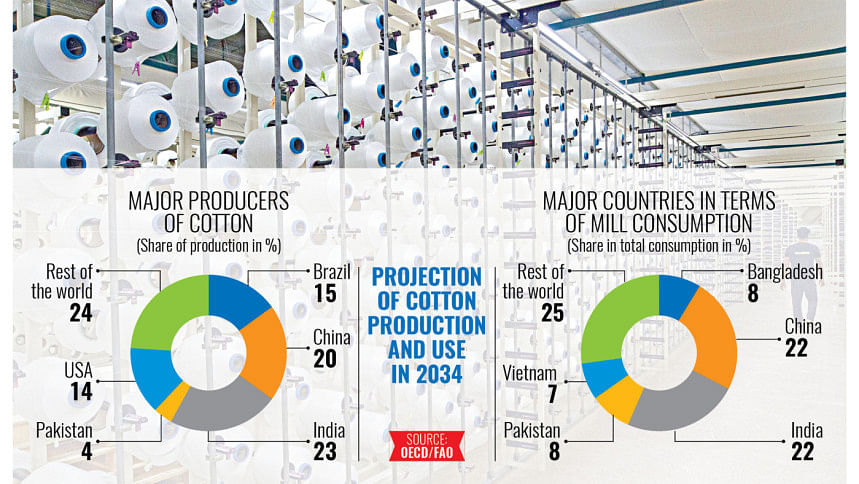Bangladesh, Vietnam to drive global cotton trade next decade: report

Bangladesh and Vietnam will drive global cotton trade over the next decade as mills increase their use of it in making yarn for export-oriented garments, said a recent global report.
World cotton trade is projected to expand steadily over the next decade by 1.6 percent annually and reach 12.3 million tonnes in 2034, said the Organisation for Economic Co-operation and Development (OECD) and Food and Agriculture Organization (FAO).
"This growth is driven by the increasing demand for textiles in Asian countries, particularly Vietnam and Bangladesh, where mill use is expanding rapidly," said the OECD‑FAO Agricultural Outlook 2025‑2034, released on July 15.
Bangladesh is projected to account for 18 percent of global raw cotton imports by 2034, registering a yearly 2.4 percent growth.
The country consumes over 1.7 million tonnes of cotton and imports more than three-fourths of its requirement.
The report said global use of raw cotton is projected to grow by 1.2 percent annually, driven by increasing demand for textiles in middle- and low-income countries.
"Asia will remain the primary hub for the processing of raw cotton, with expansion in Vietnam, Bangladesh, and India fuelled by competitive labour and production costs," it said.
Bangladesh and Pakistan are each projected to consume 8 percent of the world's total cotton.
China is expected to gradually lose its dominance in global cotton processing, but it will remain the world's largest cotton processor by 2034, followed by India.
China will consume 30 percent and India 22 percent by the end of the decade.
A rise in labour costs and stringent labour and environmental regulations has led to a gradual decrease in China's cotton mill consumption since 2010.
This decline was further exacerbated by the abolition of the support price system, a form of market intervention by the government, in 2014.
"This contributed to a move to other Asian countries, notably Vietnam and Bangladesh," said the report.
It said since the phase-out in 2005 of the Multifiber Arrangement, countries such as Bangladesh and Vietnam have experienced strong growth in their textile industries based on an abundant labour force, low production costs, and government support measures.
The Multifiber Arrangement was established in 1974 to impose quotas on the amount of clothing and textiles that developing countries could export to developed nations in Europe and the United States.
The European Union's duty-free access to least developed countries under the Generalized System of Preferences (GSP) boosted Bangladesh's textile industry, contributing to its emergence as a major global exporter of apparel, particularly knitted and woven garments, said the report.
The expansion of textile industries in Asian economies is expected to continue to boost mill consumption growth over the coming decade.
Vietnam will take the lead in annual growth of mill use at 2.7 percent per year, followed by Bangladesh at 2.1 percent per annum.
The OECD-FAO report said global cotton production is expected to grow by 1.3 percent annually, primarily driven by yield improvements, reaching 29.5 million tonnes by 2034.
"India is projected to surpass China as the world's largest cotton producer, as it is expected that India will considerably increase cotton yields from its current low levels. Brazil and the United States will follow at similar levels of production," it said.
"As major producers and exporters, Brazil and the United States are expected to meet the growing demand from Asian countries and will be the two largest exporters over the next decade," it added.

 For all latest news, follow The Daily Star's Google News channel.
For all latest news, follow The Daily Star's Google News channel. 



Comments